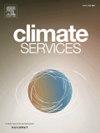揭示孟加拉国的热浪事件:来自观测记录和ERA5再分析数据的见解
IF 4.5
3区 环境科学与生态学
Q2 ENVIRONMENTAL SCIENCES
引用次数: 0
摘要
热浪的频率和强度正在不断升级,对全球人类健康、农业和基础设施构成严重风险。然而,缺乏普遍接受的卫生保健定义使各地区一致的特征变得复杂。在孟加拉国这个日益容易受到极端高温影响的亚热带国家,人们对卫生系统的动态仍然了解不足。这项研究的目的是通过分析30年的观测数据,利用环境温度和表观温度指标来表征孟加拉国的高温天气,从而弥合这一知识差距。采用5个HW指数评估24小时(EHF)、白天(CTX90pct、TX90)和夜间(CTN90pct、TN90) HW模式,并通过视温指数纳入湿度效应。卫生事件被定义为持续至少连续三天的事件,反映了长期接触的健康风险增加。根据频率、持续时间、强度和早期发病模式对HWs进行评估。将台站观测值与ERA5再分析数据得出的相应估计值进行比较。在孟加拉国,日温度的第90个百分位数成为HW表征的可靠操作阈值。高温天气期间温度变率的下降与对短期变率敏感或不受季节性影响的指数强度降低有关。湿度对夜间HWs的影响大于对日间事件的影响,而季风前和季风后的温度和湿度的季节变化对HWs特征有显著影响。这些发现为了解孟加拉国HWs的时空动态提供了新的见解,为面临类似气候威胁的其他亚热带地区的适应战略提供了证据基础。实际意义本研究对孟加拉国卫生保健面临的日益严峻的挑战提供了重要的见解,突出了其日益增加的频率、持续时间、强度和早期发病。研究结果强调了采用每日温度的第90个百分位数作为HW特征的可靠阈值的重要性,该阈值适合孟加拉国的亚热带气候。该研究揭示了不同的区域和季节模式,沿海地区经历了长时间的高温和湿度驱动的夜间活动,这大大扰乱了夜间的恢复和生产力。政策制定者可以利用这些见解制定本地化的缓解策略,例如早期预警系统、城市热管理计划和基础设施改造,以减少HW的影响。结果强调了湿度在加剧热应激中的作用,要求在HW评估中考虑环境温度和表观温度指标的综合方法。此外,本研究中使用的方法可转移到其他类似的气候背景下,使其结果对孟加拉国以外面临类似挑战的地区的政策提供有价值的信息。通过解决观测数据中的差距,并在未来的研究中纳入室内热应力和连续地表数据,这些发现为设计更强大的气候适应能力框架提供了一条途径。这些措施对于保护弱势群体、确保公共卫生以及尽量减少当地和全球极端高温事件造成的社会经济损失至关重要。本文章由计算机程序翻译,如有差异,请以英文原文为准。
Unveiling heatwave events in Bangladesh: Insights from observational records and ERA5 reanalysis data
Heatwaves (HWs) are escalating in frequency and intensity, posing serious risks to human health, agriculture, and infrastructure worldwide. However, the lack of a universally accepted definition of HWs complicates consistent characterization across regions. In Bangladesh, a subtropical country increasingly vulnerable to extreme heat, the dynamics of HWs remain insufficiently understood. This study aims to bridge that knowledge gap by analyzing three decades of observational data to characterize HWs in Bangladesh, using ambient and apparent temperature metrics. Five HW indices were employed to assess 24-hour (EHF), daytime (CTX90pct, TX90), and nocturnal (CTN90pct, TN90) HW patterns, with humidity effects incorporated through apparent temperature-based indices. HWs were defined as events lasting at least three consecutive days, reflecting the heightened health risks of prolonged exposure. HWs were evaluated in terms of frequency, duration, intensity, and early onset patterns. Station-based observations were compared against corresponding estimates derived from ERA5 reanalysis data. The 90th percentile of daily temperature emerged as a robust operational threshold for HW characterization in Bangladesh. Declines in temperature variability during HW events were linked to reduced intensities for indices sensitive to short-term variability or independent of seasonality. Humidity exerted a stronger influence on nocturnal HWs than on daytime events, while seasonal variations in temperature and humidity during the pre- and post-monsoon periods significantly shaped HW characteristics. These findings provide new insights into the spatiotemporal dynamics of HWs in Bangladesh, offering an evidence base to inform adaptation strategies in other subtropical regions facing similar climate threats.
Practical implications
This study provides critical insights into the growing challenges of HWs in Bangladesh, highlighting their increasing frequency, duration, intensity, and earlier onset. The findings underscore the importance of adopting the 90th percentile of daily temperature as a reliable threshold for HW characterization, tailored to Bangladesh’s subtropical climate. The study reveals distinct regional and seasonal patterns, with coastal areas experiencing prolonged HWs and humidity-driven nocturnal events, which significantly disrupt nighttime recovery and productivity. Policymakers can leverage these insights to develop localized mitigation strategies, such as early warning systems, urban heat management plans, and infrastructure adaptations to reduce HW impacts. The results emphasize the role of humidity in intensifying heat stress, calling for integrated approaches that consider both ambient temperature and apparent temperature metrics in HW assessments. Furthermore, the methodology used in this study is transferable to other similar climatic contexts, making the results valuable for informing policy in regions beyond Bangladesh that face comparable challenges. By addressing gaps in observational data and incorporating indoor heat stress and continuous surface data in future research, the findings offer a pathway to designing more robust climate resilience frameworks. These measures are essential for safeguarding vulnerable populations, ensuring public health, and minimizing socio-economic losses from extreme heat events both locally and globally.
求助全文
通过发布文献求助,成功后即可免费获取论文全文。
去求助
来源期刊

Climate Services
Multiple-
CiteScore
5.30
自引率
15.60%
发文量
62
期刊介绍:
The journal Climate Services publishes research with a focus on science-based and user-specific climate information underpinning climate services, ultimately to assist society to adapt to climate change. Climate Services brings science and practice closer together. The journal addresses both researchers in the field of climate service research, and stakeholders and practitioners interested in or already applying climate services. It serves as a means of communication, dialogue and exchange between researchers and stakeholders. Climate services pioneers novel research areas that directly refer to how climate information can be applied in methodologies and tools for adaptation to climate change. It publishes best practice examples, case studies as well as theories, methods and data analysis with a clear connection to climate services. The focus of the published work is often multi-disciplinary, case-specific, tailored to specific sectors and strongly application-oriented. To offer a suitable outlet for such studies, Climate Services journal introduced a new section in the research article type. The research article contains a classical scientific part as well as a section with easily understandable practical implications for policy makers and practitioners. The journal''s focus is on the use and usability of climate information for adaptation purposes underpinning climate services.
 求助内容:
求助内容: 应助结果提醒方式:
应助结果提醒方式:


